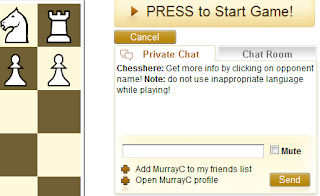What do you think when you say chess? Yes, two people sat down by a chess board from their own side, thinking most of the time, handling their pieces from time to time and struck their clock button. Oh yes, I have seen also two people at the chess board, handling their pieces stressfully without any break, beating on their clock button with violence and thinking only in the spare time. Those scenarios are two typical examples of classic chess games (the second one is the so called blitz game).
Wait a moment. There is another kind of game, historically very important. It is correspondence chess. Two players exchange their moves by mail. There is no time constraint (or they are quite long).
Correspondence chess is easily implemented over internet. Each move is stored in a database and the player simply could be notified by e-mail that the opponent move has been issued. This kind of game is sometime called turn based game or postal game. A game of this kind must have an end, so there are long time limits to finish the game and to make a single move (I’m talking about days). Furthermore, what happens if you have a game in place from days but you have to go far from your (or any) PC for any reason but you don’t want to lose? Providers of such kind of chess game give you the possibility to go on “vacation” for a period: the game is simply suspended and everybody is happy. Vacation time is limited of course and during a game you cannot go on vacation more than a certain number of times.
The equivalent of classic chess is live chess or real time chess. In this case the chess clock plays a crucial role because the time variable can condition the game (and let people to make mistakes but that’s part of the beauty of the game). Often you can chose the time control with an extra time per move rather than the sudden-death approach: you will see two numbers when you chose the time limits, the first is the amount of time a player has in order to finish the game while the second is the bonus in seconds added to your clock every move you make. In the sudden-death time control when the time expires there is no time to play a single move.
Now, think at the following scenario: you are playing a live chess game, make your move and your clock stops while your opponent’s one starts (automatically done by the client program – what a great privation! I loved pushing the button on my classic chess clock.) but your opponent won’t see the move instantly because, due to the connection speed, the move information has to be uploaded to the server and forwarded to the opponent client. This time is called lag. Your opponent will see your chess clock going on for the time of the lag and when the move is received the clock goes back to the real time stamp.

Figure 3 – Lag example: client A sends its move to the server which forwards it to the client B. Client B receives the move and starts counting the time of B (Tb). When B moves it sends to server both the move and the time spent for the move Tb. Due to delay in B connection, the server receives the information after a time called LAG. In the meantime the clock B of the client A was ticking down and when A receives the opponent move and time, the clock B is updated and it appears player B has gained time, but it has not.
Any consequences? The total game time is longer that the one agreed at the beginning of the game. This is not a big issue because the lag time is a dead time for both players. Nasty instead is the situation very closed to the time zero: you make your move at 0:00:03 but your opponent receives it only after 5 sec. In the meantime your opponent sees your clock becoming negative and starts thinking happily about the victory but then receives your move and … checkmate! Gosh!
It is not advised to play rated games when a player has great lag and some web sites does not allow playing blitz games in case of consistent lag, in fact delays of seconds in the connection could make lightening games unfeasible.
Sometimes the players recognize the lag is increasing too much during a game and the provider gives them the possibility to
abort the game or to
adjourn to another day.
Some chess playing web sites have different approaches to lag phenomenon:
- simply don’t do anything;
- lag compensation: clocks are compensated with average lag. The perception of excessive lag effect is reduced and the lag is continuously measured;
- automatic abort or adjourn of the game
- not automatic abort or adjourn of the game but players agreed upon that adopt policies in case of lag
Very
poor connections are affected by
interruptions. Some good web sites takes care of poor internet connection of its users, when the disconnection arises the game is adjourned automatically or the user online gets notified to wait more, giving the time necessary for the disconnected user to reconnect and continue the game. That could lead to cheating problem and needs to be faced with (see security section).





